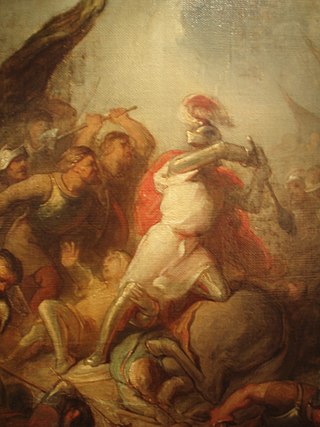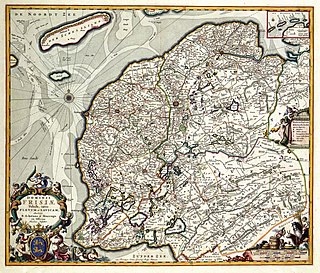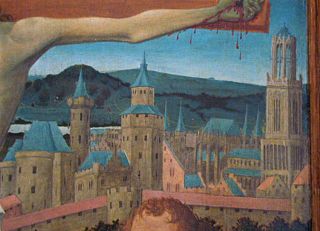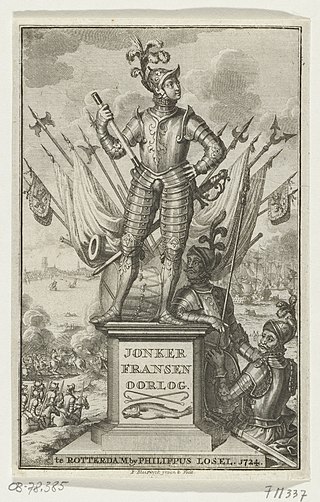Related Research Articles
Year 1432 (MCDXXXII) was a leap year starting on Tuesday of the Julian calendar.

Utrecht, officially the Province of Utrecht, is a province of the Netherlands. It is located in the centre of the country, bordering the Eemmeer in the north-east, the province of Gelderland in the east and south-east, the province of South Holland in the west and south-west and the province of North Holland in the north-west and north. The province of Utrecht has a population of about 1,388,000 as of January 2023. With a land area of approximately 1,484 square kilometres (573 sq mi), it is the second smallest province in the country. Apart from its eponymous capital, major cities and towns in the province are Amersfoort, Houten, IJsselstein, Nieuwegein, Veenendaal and Zeist. The busiest railway station in the Netherlands, Utrecht Centraal, is located in the province of Utrecht.

The Hook and Cod wars comprise a series of wars and battles in the County of Holland between 1350 and 1490. Most of these wars were ostensibly fought over who should hold the title of "Count of Holland", but some have argued that the underlying reason was a power struggle conducted by the bourgeois in the cities against the ruling nobility.

The County of Holland was a state of the Holy Roman Empire and from 1433 part of the Burgundian Netherlands, from 1482 part of the Habsburg Netherlands and from 1581 onward the leading province of the Dutch Republic, of which it remained a part until the Batavian Revolution in 1795. The territory of the County of Holland corresponds roughly with the current provinces of North Holland and South Holland in the Netherlands.
Jan van Schaffelaar was a cavalry officer in the duchy of Guelders, the Netherlands. Born in the region of Barneveld in the Veluwe Quarter about 1445, he was in the military service of David of Burgundy, the Bishop of Utrecht during the region's factional war known as the Hook and Cod Wars. He famously jumped to his death to spare his besieged troops.

Westbroek is a village in the Dutch province of Utrecht. It is a part of the municipality of De Bilt, and lies about 6 km northwest of Bilthoven.

The Battle of Zwartewaal was a decisive naval battle during the Hook and Cod wars.
The Zoudenbalch family was one of the most prominent families of Utrecht throughout the Middle Ages to the age of the Dutch Revolt. They occupied all posts of importance in the city government, possessed various lordships in the vicinity and played a leading role in the history of the Sticht. The Zoudenbalchs were also Lords of the island of Urk in the Zuiderzee for over a century (1476–1614), and as such played a key role in the life of that community during troubled times in the 16th century.

The Battle of Ane, was fought in 1227 between Otto II of Lippe, Bishop of Utrecht, and Rudolf II van Coevorden with his army of Drenths. The account of the battle comes from Quedam narracio de Groninghe de Trentis de Covordia et diversis aliis sub episcopis traiectensibus, a manuscript from the early 13th century.

David of Burgundy was the bishop of Utrecht from 1456. The illegitimate son of Philip the Good, Duke of Burgundy, David was made bishop by his father in an attempt to enforce more centralised Burgundian control over the Netherlands. He also served as bishop of Thérouanne from 1451 to 1456. He is the third longest-reigning bishop of Utrecht after Balderic and Willibrord, holding the see until his death in 1494.

John III of Egmont was first Count of Egmont, Lord of Baer, Lathum, Hoogwoude, Aarstwoude, Purmerend, Purmerland and Ilpendam, and Stadtholder of Holland, Zeeland and West-Friesland.

The Seignory of Frisia or Seignory of Friesland was a feudal dominion in the Netherlands. It was formed in 1498 by King Maximilian I and reformed in 1524 when Emperor Charles V conquered Frisia.
The Utrecht war of 1456–1458 was a diocesan feud taking place between 1456 and 1458 in the Prince-Bishopric of Utrecht following the death of Rudolf van Diepholt. It can be considered part of the Hook and Cod wars. There was an aftermath from 1470 to 1474.
The siege of Utrecht took place between June 23 and August 31, 1483 as part of the Hook and Cod wars and the Second Utrecht Civil War.

The Utrecht war of 1481–83 was a diocesan feud in the Prince-Bishopric of Utrecht between 1481 and 1483, influenced by the ongoing Hook and Cod wars in the neighbouring County of Holland. It was also a battle for control over Utrecht between the Dukes of Burgundy in the person of ruling Bishop David of Burgundy, and the Duchy of Cleves, which sought to replace him with Engelbert of Cleves.
Westbroek is a village in the Dutch province of Utrecht.

The Cod Alliance Treaty was a 1350 or 1351 treaty by which a number of nobles and cities allied with William V of Holland against his mother Margaret II, Countess of Hainaut and her allies. It was signed in the first phase of the Hook and Cod wars.
The siege of Gouda (1428) was a siege that ended the second phase of the Hook and Cod wars.
The Siege of Geertruidenberg (1351–1352) was a long siege of Geertruidenberg Castle during the first of the Hook and Cod wars.

The Squire Francis War took place in the County of Holland between November 1488 and August 1490. It was the last outburst of the Hook and Cod wars. A Hook minority captured Rotterdam in early November 1488, and from there attempts were made to get towns and villages to become Hookist. This faction was led by Frans van Brederode, a squire and descendant of an illustrious noble family. Frans revolted against the provincial administration of stadholder John III of Egmont dominated by the Cod.
References
- 1 2 Bührmann, Frans C. (1867). Bührmann's Geschiedenis van ons Vaderland van de vroegste tijden tot op heden. Vol. IV: Van het jaar 1433–1543 (in Dutch). Amsterdam: Bührmann. p. 98. OCLC 69226799.